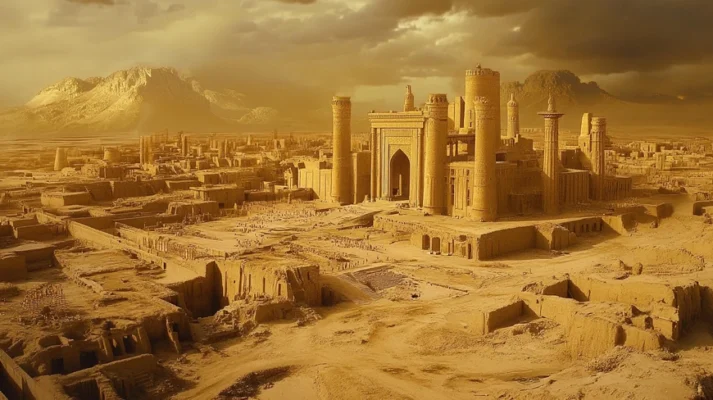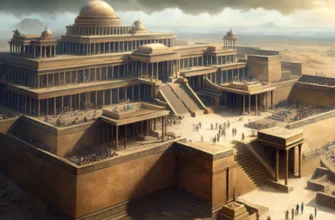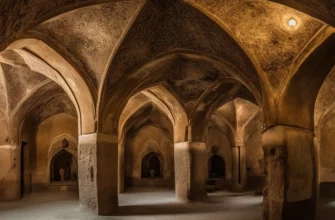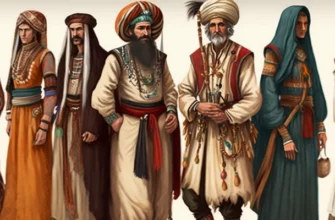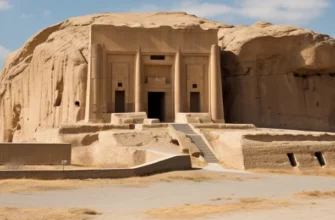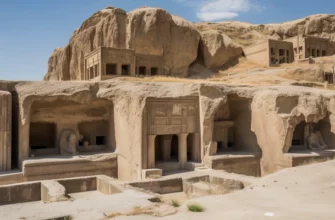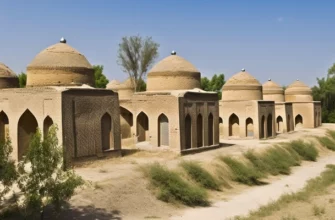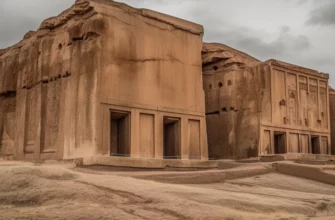Ctesiphon was one of the largest and most important cities of ancient Iran, located east of the Tigris River, near modern Baghdad, Iraq. The city became the capital of the Sassanid Empire in the 3rd century AD, replacing Persepolis.
Ctesiphon was the center of political, economic, and cultural life in Iran, and its architecture became a symbol of the empire’s power. The construction of the great hall of Tagh-i-Qasr, one of the largest buildings of its time, with a dome reaching impressive heights, was of particular importance.
The city also became an important center of trade, science, and religion, with numerous temples, libraries, and educated people.
The decline of Ctesiphon came after the city was conquered by the Arabs in the 7th century, which led to its partial destruction and decline. However, the legacy of Ctesiphon has left a deep mark on the culture and history of Iran, and archaeologists continue to study the remains of this great city, which provide valuable evidence of the grandeur of the Sassanid civilization.
- Foundation and heyday of the city
- Role in the Sassanid Empire
- Architectural features of Ctesiphon
- The Great Hall of Tagh-i-Qasr
- Fortresses and city walls
- Culture and life in Ctesiphon
- Technical achievements and crafts
- Religious life and temples
- The decline and legacy of Ctesiphon
- Current status and archaeological excavations
- Prospects for preservation and restoration
- Conclusion
Foundation and heyday of the city
The foundation of Ctesiphon dates back to the Achaemenid Empire, although the exact date of its founding is unknown. The city gained great popularity and importance in the 3rd century AD when it became the capital of the Sassanid Empire. After Shapur I, the Persian king, defeated the Roman emperors, he chose Ctesiphon as the capital of his empire because of its strategic location on the Tigris River, which allowed him to control important trade routes between the East and West.
The city became the center of political, economic, and cultural life of the Sassanids. Its heyday lasted for several centuries and coincided with the reign of the Sassanid dynasty, particularly during the reigns of Shapur I, Ardashir I, and Khosrow I. Ctesiphon became a symbol of the power and grandeur of the Sassanid Empire thanks to its huge architectural projects, including the famous Tag-i-Qasr, an impressive domed hall that was one of the largest in the world at the time.
In addition, the city became an important commercial and cultural center where different civilizations intersected. Ctesiphon was known not only for its architectural heritage, but also for its developed crafts, sciences, particularly medical knowledge, and as a center of Zoroastrianism.
By the middle of the 7th century, during its heyday, Ctesiphon was one of the largest and most powerful capitals of the Middle East. However, after the Arab conquest in the middle of the 7th century, its role significantly diminished, and the city gradually declined.
Role in the Sassanid Empire
Ctesiphon played a key role in the Sassanid Empire, being its capital and political, economic, and cultural center. Founded as a strategically located city on the Tigris River, Ctesiphon became the heart of the Sassanid state, controlling important trade routes between the East and West. Thanks to its geographical location, the city became an important hub for trade and cultural exchanges between different civilizations, particularly between Persia, Rome, India, and China.
As the capital of the Sassanid Empire, Ctesiphon was an administrative center, housing the residences of emperors, government institutions, and military headquarters. It was also important for Zoroastrianism, which was the state religion, as the city was home to significant Zoroastrian temples and educational institutions that supported religious and cultural education.
In addition, Ctesiphon was a center of art and science. Architectural achievements, particularly the great hall of Tagh-i-Qasr, became a symbol of the grandeur of the Sassanid Empire. The city was also important for the development of Persian literature, medicine, and astronomy.
Ctesiphon was also of strategic importance during military conflicts. As the center of the empire, the city was one of the main places for mobilizing the Sassanid military forces, especially during the long wars with the Roman Empire and later with the Arabs.
Thus, Ctesiphon was not only the political capital but also the cultural and religious center that reflected all the power and influence of the Sassanid Empire.
Architectural features of Ctesiphon
The architecture of Ctesiphon is one of the most significant and impressive in the Sassanid Empire. The city became a center of innovation in construction and architectural design, and its architectural features became a model for many subsequent cultures in the Middle East.
One of the most notable architectural landmarks of Ctesiphon is the Tagh-i-Qasr (Qasr Dome), which was part of the royal palace. This huge building with an impressive dome, which was one of the largest in the world at the time, is a symbol of the engineering prowess of the Sassanids. The dome was built without the use of supporting columns and was an important achievement in architecture, influencing construction in other parts of the world. The size of the hall and its construction testify to the technical achievements of the Sassanid architects, who used the latest methods to create spacious and large rooms.
The fortresses and city walls of Ctesiphon were another important architectural feature. The city was surrounded by massive walls with battlements and defensive towers that protected it from enemies. The towers rising above the city not only served a defensive function but also symbolized the greatness of the empire.
In addition, palaces, temples, and libraries were built in Ctesiphon, demonstrating the high level of culture and science in the empire. The city had a well-developed system of canals and water supply, which provided residents with drinking water and also helped irrigate the surrounding lands.
Religious buildings, particularly Zoroastrian temples, also had their own architectural features, often with tall fire towers symbolizing the importance of fire in Zoroastrianism. Religious ceremonies were held in these temples, and the architecture was designed to create a majestic and spiritual space.
Overall, the architectural features of Ctesiphon reflected not only the technical achievements of the Sassanids, but also their culture, religious beliefs, and aspirations for greatness.
The Great Hall of Tagh-i-Qasr
The Great Hall of Tagh-i-Qasr (sometimes also called the “Dome of Qasr”) is one of the largest and most famous architectural monuments of ancient Ctesiphon. This building became a symbol of the architectural and engineering prowess of the Sassanid Empire and is an important part of the heritage of this civilization.
The hall was part of a palace built during the reign of King Khosrow I (531-579 AD) and was probably used to receive important guests and hold official ceremonies. Its main architectural feature is its huge dome, one of the largest and highest in the world at the time. The dome was over 25 meters in diameter and was built without the use of supporting columns, which was a significant engineering achievement.
Another distinctive feature of this hall is its spaciousness. It was one of the largest enclosed spaces in the ancient world, allowing for large gatherings and ceremonies to be held. The hall was also an important part of the architectural ensemble, which included other palace buildings, temples, towers, and defensive structures.
Technical achievements in the construction of Tagh-i-Qasr include the use of innovative methods to create such large spaces without using traditional structures. The dome was erected using a special system of arches and piers, which allowed it to withstand significant loads and ensure the stability of the building for many centuries.
Unfortunately, today Tag-i-Qasr is partially destroyed, and most of its walls and dome have been preserved only in fragments. Despite this, the remains of this hall are a testament to the high level of engineering and architecture of the Sassanids. Its grandeur and impressive size made Tagh-i-Qasr one of the greatest architectural achievements of Ancient Iran, which still attracts the attention of archaeologists, historians, and tourists.
Fortresses and city walls
The fortresses and city walls of Ctesiphon were an important part of its architectural and defensive complex. Due to its strategic location on the Tigris River and its importance as the capital of the Sassanid Empire, Ctesiphon needed effective protection from enemies and invasion. The city’s walls and fortresses were designed to withstand attacks and control access to the city.
The city walls of Ctesiphon were huge and powerful, built of brick, a typical material for many Sassanid structures. The walls were thick and rose to a considerable height to provide protection from attack. They were equipped with loopholes — narrow openings in the walls for firing arrows and other projectiles at enemies. The walls were also equipped with defensive towers, which increased the effectiveness of the defenses by providing a vantage point from which to observe the surrounding area.
In addition to the city walls, fortresses were built around Ctesiphon, which served not only as defensive structures but also as important administrative centers. The fortresses helped protect key areas of the city, such as palace complexes and religious buildings. They were also used to house military units tasked with defending the city from attacks, particularly from Roman troops or later Arab conquerors.
The defensive walls and fortresses of Ctesiphon were part of a large fortification system that also included numerous towers, gates, and defensive canals, which provided an additional level of defense. This was especially important during the period of numerous wars with the Roman Empire and later with the Arabs, when the city became the target of numerous attacks.
Although part of the city walls and fortresses have not survived to this day, the remains of these architectural elements give an idea of the power and importance of Ctesiphon as a defensive center in the Sassanid Empire.
Culture and life in Ctesiphon
The culture and life of Ctesiphon, as the capital of the Sassanid Empire, were a vivid reflection of the greatness and development of this civilization. The city became the center not only of political power, but also of the cultural, scientific, religious, and economic life of the empire. Ctesiphon was a crossroads of different cultures and ideologies, which had a great influence on its development.
Culture of Ctesiphon: Ctesiphon was an important center for the development of science, art, and literature. The city had large libraries and educational institutions where scholars and philosophers from all over the region gathered. The city became an important center for the preservation and development of Persian literature, as well as for the translation of classical Greek and Roman works into Middle Persian. In addition, medicine, astronomy, and mathematics were well developed in Ctesiphon.
Sasanian culture was closely linked to religion. Zoroastrianism, as the state religion, had a great influence on everyday life. Numerous Zoroastrian temples were built in Ctesiphon, where religious ceremonies were held. Fire, which was a symbol of purity and divine power, was important in religious ceremonies and was kept burning in temple hearths.
Life in Ctesiphon: Life in Ctesiphon was quite luxurious for the upper classes, especially the royal family, the aristocracy, and high-ranking officials. They lived in huge palaces decorated with exquisite frescoes, mosaics, and various decorative elements. The palaces had large halls for receptions and ceremonies, as well as cozy courtyards with fountains, gardens, and decorative plants.
Daily life in the city was closely linked to crafts and trade. Ctesiphon was an important trading center where not only local goods were exchanged, but also products from other parts of the Sassanid Empire, as well as from China, India, and the Roman Empire. On the streets of the city, you could see craftsmen working in workshops where they made items from metal, leather, fabric, and clay.
The social structure of Ctesiphon was hierarchical, with a clear division between the aristocracy, craftsmen, merchants, and slaves. Workers, merchants, and artisans lived in more modest conditions, often in crowded areas of the city where houses were small and simple. However, even in such conditions, some crafts, such as jewelry making and textiles, were of great importance and brought significant profits.
Special attention was paid to food and hospitality. The food in Ctesiphon was varied, with many spices brought from India and other parts of Asia. It is known that meat, fruit, bread, and wine were popular in Sassanid society. Coffee shops and restaurants were an important part of social life, where people gathered to exchange news and entertainment.
Thanks to its rich cultural life, Ctesiphon became not only a political and economic center, but also a major cultural center that contributed to the development of Persian civilization and left a significant mark on the history of the Middle East.
Technical achievements and crafts
The technical achievements and crafts of Ctesiphon reflect the high level of development of the Sassanid civilization in many areas. The city was not only a political and cultural center, but also a hub of innovation in construction, science, and crafts. The technical achievements in Ctesiphon laid the foundation for the development of architecture, medicine, mechanics, and many other fields.
Technical achievements:
Architecture and engineering:
One of the greatest technical achievements of the Sassanids was the huge hall of Tagh-i-Qasr, whose dome, with a diameter of over 25 meters, was one of the largest in the world at that time. It was built without supporting columns, which made it unique from an architectural point of view.
An advanced irrigation and canal system helped Ctesiphon develop as an important economic and agricultural center. This system was used to irrigate fields and supply water to the city itself.
Sasanian architects and engineers achieved significant success in the construction of fortifications. The city walls and fortresses of Ctesiphon were built of sturdy brick, and their design was effective for defense against attacks. High towers and battlements allowed the city to be defended against enemies, while powerful gates and wickets served as the last line of defense.
Medicine and science:
Ctesiphon was an important center of medical knowledge. The Sassanids made significant advances in medicine, particularly in surgery and the treatment of diseases. The doctors of Ctesiphon used innovative methods of treatment, particularly for surgical operations and wound care.
Many classical medical texts were translated into Middle Persian in Ctesiphon, which became the basis for the further development of medical knowledge in the Arab world.
Astronomy and mechanics:
Sasanian scientists made significant contributions to astronomy. They observed celestial bodies and developed astronomical tables and calendars. The astronomical observatories in Ctesiphon became important centers for the study of celestial phenomena.
Mechanical inventions were also important, such as water mills for grinding grain, which used water power to perform work. This was a technical achievement that simplified processes in agriculture and industry.
Crafts:
Textiles and carpets:
The craft of textile manufacturing was one of the most developed in Ctesiphon. Persian fabrics, particularly silk carpets and fabrics, became popular throughout the Middle East and Europe. High-quality fabrics were produced using complex weaving techniques and decorated with embroidery and dyeing.
Persian carpets, known for their high quality and artistic design, gained international fame and became a symbol of Persian culture.
Metallurgy:
The craft of metallurgy in Ctesiphon reached a high level. Persian craftsmen produced weapons and tools from iron and bronze, as well as decorative items from gold and silver. High-quality jewelry from the Persian Empire was renowned for its craftsmanship.
Iron and steel were used to make not only tools, but also important military items such as swords, spears, and shields.
Pottery and ceramics:
Pottery was also well developed in Ctesiphon. Craftsmen produced a variety of ceramic items that were not only functional but also artistic. Persian ornaments and images illustrating everyday life, religious scenes, or mythological motifs can often be seen on ceramic items.
Building crafts:
Building crafts in Ctesiphon were highly developed thanks to the use of special technologies, in particular for the manufacture of bricks, which were used to build fortifications and palaces. Builders used special masonry techniques that allowed them to create stable and durable structures.
Thus, the technical achievements and crafts of Ctesiphon not only contributed to the development of the city, but also became an important part of the cultural heritage that influenced the further development of the Middle East and neighboring regions.
Religious life and temples
Religious life and temples in Ctesiphon were of great importance for the social, cultural, and political life of the Sassanid Empire. Ctesiphon was not only an administrative center but also an important religious center where Zoroastrianism, the official religion of the Sassanids, prevailed and had a huge impact on everyday life, social structures, and cultural practices.
Zoroastrianism in Ctesiphon:
Zoroastrianism, founded by the prophet Zoroaster (or Zarathustra), was the main religion of the Sassanid Empire and became a central part of Ctesiphon’s culture. The belief in fire as a symbol of divine light and purity was of particular importance in religious practices. Fire was considered sacred and was kept in special temples—fire shrines—where it burned continuously.
Zoroastrianism also emphasized the concept of the struggle between good and evil, the teachings of Ahura Mazda (the chief god) and Angra Mainyu (the spirit of evil). These teachings contributed to the development of moral norms and ethics, which became the basis for social relations in Sassanid society.
Temples of Ctesiphon:
Fire temples:
The main architectural feature of religious buildings in Ctesiphon were fire temples. These were special structures where fire was kept as a sacred element of worship. The fire was kept burning constantly in special sacrificial hearths and was considered a source of divine light. Such temples were not only of great religious significance but also symbolized the strength and power of the state.
It is known that there was a large fire temple in Ctesiphon that kept the sacred fire and was one of the largest in the empire. Important religious rites and ceremonies were held in this temple.
Tag-i-Qasra Temple:
The Tag-i-Qasra Temple was part of the palace complex and had sacred significance. Its architecture was magnificent, and the temple space was used for various religious and state ceremonies. The Great Hall of the Palace in Ctesiphon, although not strictly a religious building, still had spiritual significance, as its space was used for royal ceremonies and religious festivals.
Other religious buildings:
In addition to fire temples, there were other religious buildings in Ctesiphon. These were temples dedicated to deities, as well as monasteries for teachers and religious leaders of Zoroastrianism. These buildings were used for purification ceremonies, prayers, religious celebrations, and training for future priests.
Zoroastrian priests, known as mobeds, played an important role in the society of Ctesiphon, performing rituals that were supposed to maintain order and harmony in the world.
Religious rituals and holidays:
Religious life in Ctesiphon was rich in various ritual practices and holidays.
Zoroastrian holidays were of great importance to the population, particularly those associated with important phases of the sun and changes in nature, such as the New Year celebration, which symbolized the beginning of a new cycle of nature. There were also holidays dedicated to various aspects of life: harvest, fire, sun, and other natural forces.
In addition to religious holidays, royal ceremonies were also held in Ctesiphon, which included religious rituals. The king (shah) identified himself with God, and his participation in religious ceremonies reinforced his divine status. Given the importance of the king as a spiritual leader, religious and state rituals were often intertwined.
The influence of religion on everyday life:
Zoroastrianism, as the state religion, determined not only religious life, but also social norms, morals, laws, and even hygiene practices. Sacred fire was considered a bearer of purity, and its worship required certain purification ceremonies. There were also strict rules of conduct in everyday life that helped maintain moral order in society.
After the fall of the Sassanid Empire, particularly with the beginning of the Arab conquests in the 7th century, religious life in Ctesiphon underwent significant changes. Many Zoroastrian temples and sacred fires were destroyed or converted into Muslim mosques. However, Zoroastrian traditions survived in isolated communities and became part of the cultural heritage of Persia.
Thus, the religious life of Ctesiphon was an integral part of the culture and daily life of the city, and its temples and religious practices left a deep mark on the history of the Sassanid Empire and the Middle East as a whole.
The decline and legacy of Ctesiphon
The decline and legacy of Ctesiphon were important stages in the history of this magnificent city. Ctesiphon was the capital of the Sassanid Empire for over three centuries, but its decline came amid numerous military threats, political crises, and cultural changes.
Despite its destruction, the legacy of Ctesiphon left a significant impact on the subsequent history, culture, and architecture of the region.
The decline of Ctesiphon:
Arab conquests:
One of the main reasons for the decline of Ctesiphon was the Arab occupation in the mid-7th century. After the victory of the Arab Muslims over the Sassanid forces at the Battle of Qadisiyah in 636, Ctesiphon and most of Persia fell under the control of the Arab conquerors. The last Shah of the Sassanid Empire, Yazdegerd III, tried to hold on to power, but the city proved unable to withstand the Arab onslaught.
In 651, the Arabs finally destroyed Ctesiphon, capturing it and reducing the city to ruins. Fire temples, palaces, libraries, and numerous other architectural structures were damaged or destroyed. The city lost its former grandeur, and many of its inhabitants either died or became part of the new Muslim social and cultural structure.
Role in the transition to the Arab world:
After the Arab conquest, Ctesiphon became part of the Islamic world, and its political and cultural significance was gradually replaced by the new capital, Baghdad, which was founded by the Arabs west of Ctesiphon. From this time on, Ctesiphon began to lose its importance, and its ruined buildings became only a testimony to the greatness of the former empire.
Part of the population moved to Baghdad, where new cultural and scientific traditions began to develop, but Persian culture continued to exist in a modified form within the Arab context.
The legacy of Ctesiphon:
Despite its decline and destruction, the legacy of Ctesiphon lived on in many aspects of Arab and Persian culture. Some of the main elements of this legacy include:
Architectural heritage:
The architectural achievements of Ctesiphon, particularly its fire temples, became an important part of the architectural heritage of Persia. Later Muslim architects used many elements of Sassanian architecture, particularly in the construction of domes and large, spacious halls. Large domes, such as those preserved in Baghdad, were directly inspired by Sassanian architectural techniques.
The technique of building without supporting columns (as in the Tagh-i-Qasr hall) also influenced the architecture of Muslim buildings, especially in the use of free space in large palaces and mosques.
Cultural heritage:
Ctesiphon was the center for the translation of classical Greek and Roman works into Middle Persian, which had a significant influence on the further development of the Arabic scientific and philosophical tradition. Many of these texts were transmitted to the Arab world and became the basis for the Arabic Renaissance in the Middle Ages.
Sasanian culture also had a major influence on Muslim civilization, particularly in art, literature, and science. In particular, the Zoroastrian system of ethics and morality influenced the development of Islamic concepts of justice, order, and ethics.
Linguistic heritage:
The language spoken in Ctesiphon, Middle Persian, left its mark on Arab culture and language. Many words and phrases were borrowed from Middle Persian into Arabic, which became the basis for the development of the Persian language in the Islamic period.
Religious heritage:
Zoroastrianism, which was the main religion of Ctesiphon, declined with the fall of the Sassanid Empire but did not disappear completely. Followers of Zoroastrianism continued to exist in minority communities in Iran and India (especially in the form of Parsis in India), preserving many religious and cultural traditions.
The Zoroastrian religion continued to influence cultural and religious practices in Persia even after the Arab conquest.
The legacy of Ctesiphon in the modern context:
Today, Ctesiphon remains an important historical and archaeological site that provides insight into the grandeur of the Sassanid Empire. The ruins of the city, particularly the remains of the Great Hall of Tagh-i-Qasr, are evidence of the high level of architecture and cultural development that influenced the subsequent history of the Middle East and all of Eurasia.
Thus, although Ctesiphon was destroyed and forgotten as a capital, its legacy lives on through its influence on architecture, science, culture, and religion in the Arab and Persian worlds.
Current status and archaeological excavations
The current state and archaeological excavations of Ctesiphon are an important part of the study of the history of the Sassanid Empire and its cultural heritage. The ruins of Ctesiphon, located in modern Iraq, near the city of Al-Mada’in, are a testament to the grandeur of the former city and its architectural achievements. However, due to numerous historical cataclysms, including the Arab conquest, as well as modern conflicts in the region, these ruins require significant attention for preservation and research.
The current state of Ctesiphon:
Ruins and their preservation:
Today, the remains of Ctesiphon are mainly ruins of palaces, fortresses, fire temples, and places of worship. Among the most famous architectural elements are the Great Hall of Tagh-i-Qasr, the remains of fortresses, and city walls.
The ruins of Ctesiphon are now in a condition that makes their preservation difficult: some of them were damaged as a result of military conflicts in Iraq, particularly after the 2003 war and the fighting that followed the activities of the Islamic State (ISIS). Given the limited access to these areas due to security issues, the preservation of these archaeological sites has remained a difficult task.
Threats of destruction:
The deterioration of the ruins was caused not only by military action but also by natural factors such as erosion, flooding, and heavy rains, which are gradually destroying architectural elements. Many parts of the city, including the Great Hall of Tagh-i-Qasr, are of great historical value but require restoration and special efforts to preserve them.
Archaeological excavations:
First archaeological activity:
The first serious archaeological research in Ctesiphon began in the 19th century, when European archaeologists, particularly British, conducted excavations and research on the ruins. One of the main goals was to study the architecture and find artifacts that could give more info about the history and culture of the Sassanid Empire.
The Great Hall of Tagh-i-Qasr, one of the largest structures still standing today, got a lot of attention.
Modern archaeological research:
In recent decades, archaeologists have made some efforts to resume research in the Ctesiphon area. However, due to political instability and security threats in Iraq, archaeological excavations have been significantly limited.
The latest archaeological work began in the 2000s, when new parts of the city were discovered, including unique frescoes, loopholes, coins, and cells, indicating a high level of craftsmanship and trade in Ctesiphon.
Archaeologists are using modern technologies such as ground-penetrating radar to detect architectural remains underground without the need for large-scale excavations, which helps to minimize destruction.
International initiatives:
There are several international programs and projects aimed at preserving the archaeological heritage of Ctesiphon.
In collaboration with local organizations, international archaeological institutes, and UNESCO are working on the conservation and restoration of the ruins, in particular the Great Gate and the Tagh-i-Kasra Hall, which could become a symbol of joint efforts to protect cultural heritage.
UNESCO has also included Ctesiphon on its list of sites in need of urgent protection, as it is part of the world’s cultural heritage.
Prospects for research and preservation:
Despite the difficult situation, there is hope that archaeological research in Ctesiphon will resume once the situation in Iraq stabilizes.
The restoration and preservation of these archaeological sites are of great importance not only for Iraq but for the whole world, as Ctesiphon is one of the greatest testimonies to the history and culture of ancient Iran and the Sassanid Empire.
Prospects for preservation and restoration
The prospects for the preservation and restoration of Ctesiphon are an important issue for the international archaeological community, as the ruins of this city are unique evidence of the cultural and architectural heritage of the Sassanid Empire. After numerous historical disasters, including the Arab conquest and recent conflicts in Iraq, the preservation of Ctesiphon has become a matter of great international importance. Given these challenges, several main areas for the preservation and restoration of this archaeological complex can be identified.
- International cooperation and support
Thanks to international support and cooperation between governments, archaeologists, cultural organizations, and institutions such as UNESCO and the International Council on Monuments and Sites (ICOMOS), there are opportunities for the restoration and preservation of Ctesiphon. Over the past decades, Ctesiphon has become the focus of attention of international organizations, some of which are actively working on projects to protect this world cultural heritage site.
UNESCO has already included Ctesiphon on its list of endangered sites, as the city’s architectural structures are at risk due to ongoing fighting and natural disasters.
- Use of modern technologies for research
Modern technologies offer great opportunities for researching and preserving Ctesiphon with minimal damage to archaeological sites. Here are some of these technologies:
Ground-penetrating radar and non-contact research methods: These methods allow archaeologists and restorers to detect underground architectural elements without disturbing their structure. Ground-penetrating radar surveys can help locate undiscovered parts of the city and architectural remains buried deep underground.
3D modeling and virtual restoration: These technologies allow the creation of accurate virtual models of the ruins of Ctesiphon, making it possible to explore the city in its original form and facilitating projects to restore its architecture and monuments.
Digital preservation of artifacts: Using scanning to preserve artifacts such as coins, statues, and other objects helps create digital copies that can be studied in case the originals are damaged or lost.
- Restoration and renovation of architectural objects
Restoring and renovating specific architectural objects, such as the Great Hall of Tagh-i-Kasra, is a complex and expensive process. Restoration decisions must take into account a number of factors:
Technical capabilities: In order to restore damaged parts of the city, it is necessary to have access to skilled architects, restorers, and engineers who are able to work with the materials used in Sassanian architecture. Restoration should combine the use of modern materials with original technologies and methods.
Local community involvement: It’s really important for local communities to be involved in the restoration process. This not only helps preserve cultural heritage, but also raises awareness among locals about the importance of their cultural heritage.
Priorities for restoration: Priority should be given to sites of the greatest architectural and historical value, in particular the Great Hall of Tagh-i-Qasr and other significant buildings. Restoring such architectural wonders not only preserves them but also improves the condition of the city as a whole.
- Establish restrictions to prevent further damage
The preservation of Ctesiphon also requires the prevention of further damage. This can be achieved through:
Prohibition of construction near the ruins: It is important that restrictions are placed on new construction in the Ctesiphon area that could damage the ruins or alter the surrounding environment.
Restricting access during excavations: Because archaeological research can damage sensitive sites, access to some parts of the city should be restricted to tourists and even archaeologists during active work.
- Developing tourism and cultural awareness
The preservation and restoration of Ctesiphon can also promote the development of cultural tourism. This could help attract additional funds for restoration and preservation. However, this must be done in a way that minimizes the impact on archaeological sites:
Conservation-oriented tourism: Tourist flows must be well organized and controlled so as not to damage valuable sites.
Educational programs and cultural events: Organizing programs to raise awareness of Ctesiphon among the local population and international tourists can promote a better understanding of the cultural significance of these ruins and encourage further support for restoration projects.
- Establishment of specialized research and restoration centers
The establishment of specialized centers for research and restoration on site could help to put these plans into practice. Such centers could serve as hubs for preserving the history of Ctesiphon and providing training programs and internships for future archaeologists and restorers.
The prospects for the preservation and restoration of Ctesiphon require a comprehensive approach that includes international cooperation, the use of modern technologies, restoration work, and ensuring proper management. Preserving this unique site will not only contribute to the preservation of cultural heritage but may also help develop tourism and education in Iraq and the Middle East.
Conclusion
Ctesiphon, as an important cultural and architectural center of Ancient Iran, not only leaves a deep mark in the history of the Sassanid Empire, but also has a significant influence on the development of architecture, art, and science in the region. Despite the destruction caused by the Arab conquest and later conflicts, the ruins of Ctesiphon continue to bear witness to the greatness of a past civilization.
Modern efforts to preserve and restore this archaeological complex require international cooperation, the introduction of the latest technologies, and careful planning. The preservation of Ctesiphon is not only a task for archaeologists and restorers, but also an important part of the global cultural heritage. With stability in the region and the support of the international community, it is possible to preserve these unique sites for future generations and make them accessible for research and tourism.
Thus, Ctesiphon has great potential for study and preservation, which will provide a deeper understanding of the history, culture, and architecture of the Sassanid Empire and influence the further development of the cultural heritage of Iran and the region as a whole.
